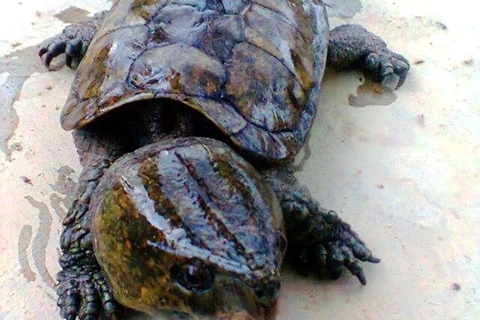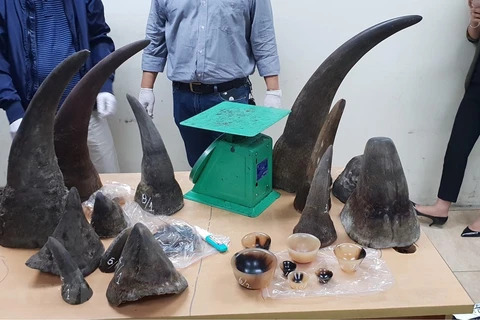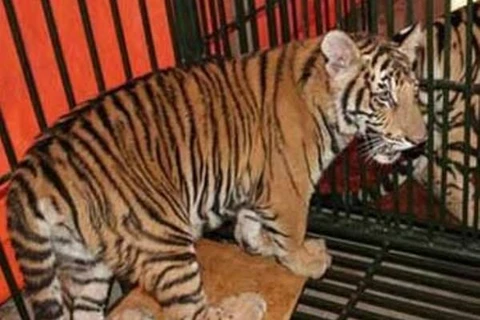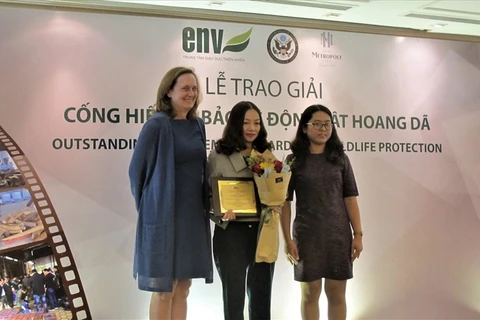Hanoi (VNA) – The trading and butchering of wildlife animals in the “red list” have been found in markets in the western region, especially Thanh Hoa agricultural product market in Long An province.
 The illegal trading of wildlife can be found easily at Thanh Hoa agricultural product market in the Mekong Delta province of Long An (Photo: VietnamPlus)
The illegal trading of wildlife can be found easily at Thanh Hoa agricultural product market in the Mekong Delta province of Long An (Photo: VietnamPlus)
Local forest rangers, however, have yet to take strong actions against the massive wildlife trafficking although they have been informed by a VietnamPlus reporter.
Quick inspections
After making fact-finding trips to markets in the Mekong Delta province of Dong Thap and detected the trafficking of rare animals there, the VietnamPlus reporter contacted and sent photos to the provincial forest protection agency whose head promised to dispatch forest rangers to the markets in the next morning.
However, the local forest rangers said they found no signs of wildlife smuggling in these markets, and they plan to carry out an inspection across the province and will inform the results to the reporter.
A similar situation was seen in Long An province where head of the provincial forest protection agency passed the buck to forest rangers at the district level.
[WWF helps Vietnam combat wildlife trafficking]
However, as the reporter could not contact the forest protection station in Thanh Hoa district, they tried to seek support from head of the Forest Protection Department Do Quang Tung.
 Many rare species of turtles are sold in the market. The market has about 40 booths with hundreds of iron cages that imprison rare birds, Asian openbills, turtles and snakes (Photo: VietnamPlus)
Many rare species of turtles are sold in the market. The market has about 40 booths with hundreds of iron cages that imprison rare birds, Asian openbills, turtles and snakes (Photo: VietnamPlus)
After a 30-minute conversation, the reporter found that traders quickly hid cages of turtles, snakes and birds. Two forest rangers rode a bike around the market, pointing at and telling something to the traders, without taking any specific actions. Their inspection lasted for about 3-5 minutes.
Astonished by the quick inspection, the reporter contacted again with Le Huu Loi, head of the provincial forest protection agency, but he insisted that forest rangers found nothing.
“We come to check the market every week,” he said no later than traders displaying these animals in the market again.
Asked why forest rangers found nothing during the inspection while wildlife animals were still put on sale before and after that, Loi explained that this problem has lingered for a long time.
“The provincial People’s Committee has established an inter-sectoral inspection group and all competent forces got involved, but the trafficking has still continued. We have no ways,” he said.
Nguyen Van Sung, head of the Thanh Hoa district forest protection station, further explained the traders know well forest rangers, so they can easily hide these animals when the forest rangers come.
Hopelessly waiting for inter-sectoral actions
After the reporter sent photos of evidence to Do Quang Tung, head of the Forest Protection Department, he promised to dispatch a special group to the site.
However, Dong Xuan Hung, deputy head of the special group of forest rangers under the Forest Protection Department, told the reporter that all of the group members were on a working trip, and pledged to conduct an inspection in the next few days.
 Burnt birds of rare species are put on sale at Thanh Hoa market. Dozens and even hundreds of transactions of birds are made in just a few days at the market. (Photo: VietnamPlus)
Burnt birds of rare species are put on sale at Thanh Hoa market. Dozens and even hundreds of transactions of birds are made in just a few days at the market. (Photo: VietnamPlus)
Later, Hung told the reporter that they had yet to conduct the inspection as scheduled, explaining that he has been asking for the permission of his senior for a joint inspection.
[Project launched to boost ties in threatened species conservation]
Thousands of turtles, snakes and birds have been killed while competent agencies are completing procedures for the inspection.
Tung further said that market management is the responsibility of local authorities who have to report wildlife smuggling cases to complement forces like police and forest rangers.
“We cannot do anything if localities take no action,” he said, insisting that to handle the problem, it needs the drastic involvement of local authorities.
 Birds are kept in iron cages to make it easier for customers to select. Hundreds of Asian openbills are forced to stay in cages, cruelly tied with sticky tape. (Photo: VietnamPlus)
Birds are kept in iron cages to make it easier for customers to select. Hundreds of Asian openbills are forced to stay in cages, cruelly tied with sticky tape. (Photo: VietnamPlus)
Among hundreds of types of wildlife animals in the “red list” put on sale, snail-eating turtle (scientifically known as Malayemys subtrijuga) and yellow-headed turtle (Heosemys annandalii) have been favoured by customers.
In the Mekong Delta region, turtles are being traded for food or ornamental purposes. Meanwhile, in the north, they are killed for bone concentration, pushing them on the verge of extinction./.























